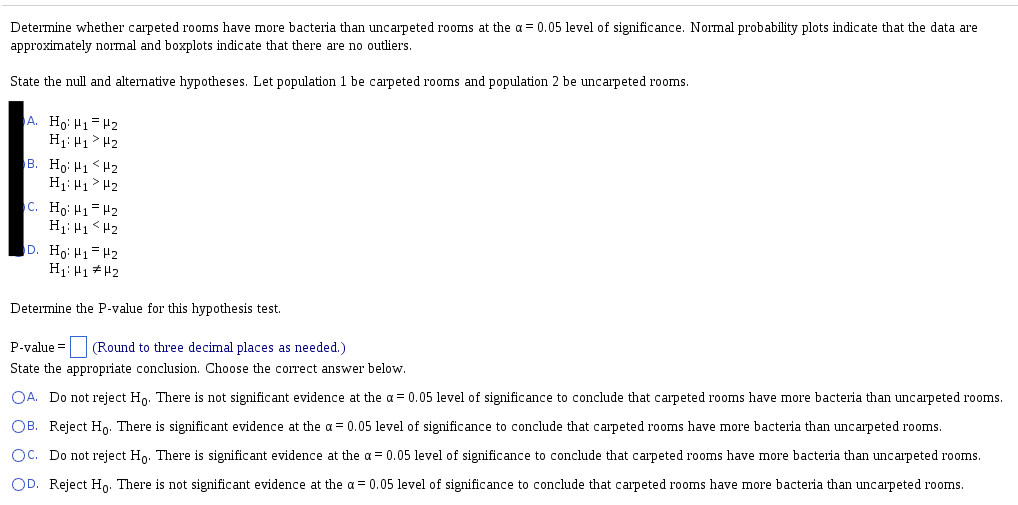Full data setD Uncarpeted 12.5 A researcher wanted to determine if carpeted rooms contain more bacteria than uncarpeted rooms. The table shows the results for the number of bacteria per cubic foot for both types of rooms. Carpeted 13.9 8.7 10.8 10.8 10.3 6 4.2 14.7 14.9 9.7 4.2 13.3 8.1 8.1 7.6 Determine whether carpeted rooms have more bacteria than uncarpeted rooms at the a= 0.05 level of significance. Normal probability plots indicate that the data are approximately normal and boxplots indicate that there are no outliers. State the null and alternative hypotheses. Let population 1 be carpeted rooms and population 2 be uncarpeted rooms.
Full data setD Uncarpeted 12.5 A researcher wanted to determine if carpeted rooms contain more bacteria than uncarpeted rooms. The table shows the results for the number of bacteria per cubic foot for both types of rooms. Carpeted 13.9 8.7 10.8 10.8 10.3 6 4.2 14.7 14.9 9.7 4.2 13.3 8.1 8.1 7.6 Determine whether carpeted rooms have more bacteria than uncarpeted rooms at the a= 0.05 level of significance. Normal probability plots indicate that the data are approximately normal and boxplots indicate that there are no outliers. State the null and alternative hypotheses. Let population 1 be carpeted rooms and population 2 be uncarpeted rooms.
MATLAB: An Introduction with Applications
6th Edition
ISBN:9781119256830
Author:Amos Gilat
Publisher:Amos Gilat
Chapter1: Starting With Matlab
Section: Chapter Questions
Problem 1P
Related questions
Question

Transcribed Image Text:A researcher wanted to determine if carpeted rooms contain more bacteria than uncarpeted rooms. The table shows the results for the number of bacteria per cubic foot for both types of rooms.
Full data set O
Carpeted
Uncarpeted
13.9
12.5
10.3
8.7
6
4.2
10.8
14.7
14.9
9.7
4.2
13.3
10.8
8.1
8.1
7.6
Determine whether carpeted rooms have more bacteria than uncarpeted rooms at the a = 0.05 level of significance. Normal probability plots indicate that the data are approximately normal and boxplots indicate that there are no outliers.
State the null and alternative hypotheses. Let population 1 be carpeted rooms and population 2 be uncarpeted rooms.

Transcribed Image Text:Determine whether carpeted rooms have more bacteria than uncarpeted rooms at the a = 0.05 level of significance. Normal probability plots indicate that the data are
approximately normal and boxplots indicate that there are no outliers.
State the null and alternative hypotheses. Let population 1 be carpeted rooms and population 2 be uncarpeted rooms.
A. Ho: H1= H2
H1: H1> H2
B. Ho: H1 <H2
H1: H1 > H2
c. Hoi H1= H2
H1: H1<H2
D. Ho: H1=H2
H1: H1##2
Determine the P-value for this hypothesis test.
P-value =
(Round to three decimal places as needed.)
State the appropriate conclusion. Choose the correct answer below.
OA. Do not reject Ho. There is not significant evidence at the a = 0.05 level of significance to conclude that carpeted rooms have more bacteria than uncarpeted rooms.
OB. Reject Ho. There is significant evidence at the a = 0.05 level of significance to conclude that carpeted rooms have more bacteria than uncarpeted rooms.
Oc. Do not reject Ho. There is significant evidence at the a = 0.05 level of significance to conclude that carpeted rooms have more bacteria than uncarpeted rooms.
OD. Reject Ho. There is not significant evidence at the a = 0.05 level of significance to conclude that carpeted rooms have more bacteria than uncarpeted rooms.
Expert Solution
This question has been solved!
Explore an expertly crafted, step-by-step solution for a thorough understanding of key concepts.
This is a popular solution!
Trending now
This is a popular solution!
Step by step
Solved in 2 steps with 3 images

Recommended textbooks for you

MATLAB: An Introduction with Applications
Statistics
ISBN:
9781119256830
Author:
Amos Gilat
Publisher:
John Wiley & Sons Inc

Probability and Statistics for Engineering and th…
Statistics
ISBN:
9781305251809
Author:
Jay L. Devore
Publisher:
Cengage Learning

Statistics for The Behavioral Sciences (MindTap C…
Statistics
ISBN:
9781305504912
Author:
Frederick J Gravetter, Larry B. Wallnau
Publisher:
Cengage Learning

MATLAB: An Introduction with Applications
Statistics
ISBN:
9781119256830
Author:
Amos Gilat
Publisher:
John Wiley & Sons Inc

Probability and Statistics for Engineering and th…
Statistics
ISBN:
9781305251809
Author:
Jay L. Devore
Publisher:
Cengage Learning

Statistics for The Behavioral Sciences (MindTap C…
Statistics
ISBN:
9781305504912
Author:
Frederick J Gravetter, Larry B. Wallnau
Publisher:
Cengage Learning

Elementary Statistics: Picturing the World (7th E…
Statistics
ISBN:
9780134683416
Author:
Ron Larson, Betsy Farber
Publisher:
PEARSON

The Basic Practice of Statistics
Statistics
ISBN:
9781319042578
Author:
David S. Moore, William I. Notz, Michael A. Fligner
Publisher:
W. H. Freeman

Introduction to the Practice of Statistics
Statistics
ISBN:
9781319013387
Author:
David S. Moore, George P. McCabe, Bruce A. Craig
Publisher:
W. H. Freeman